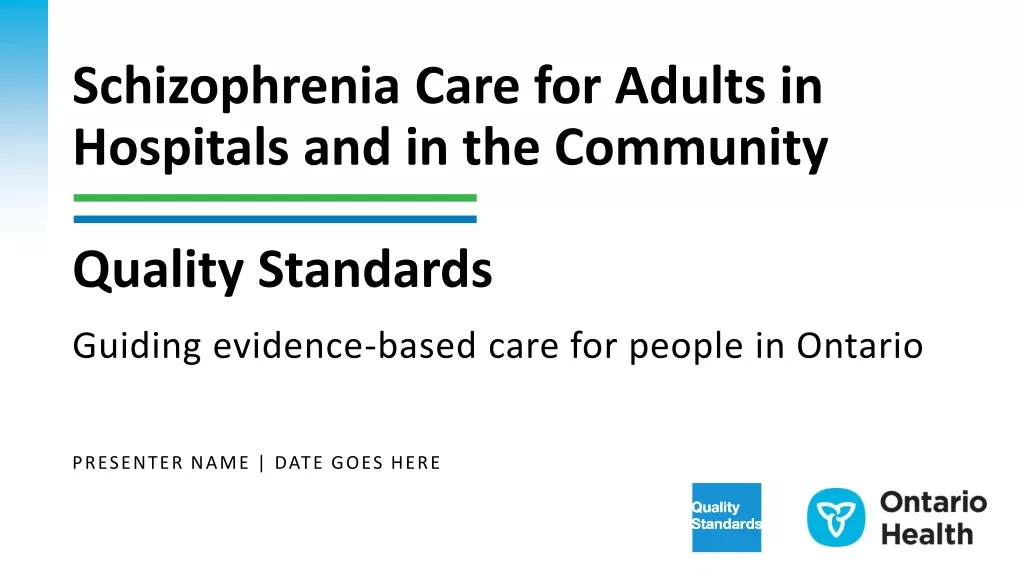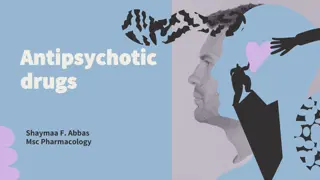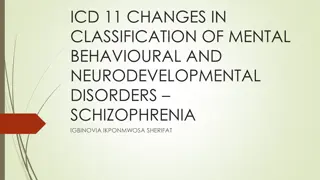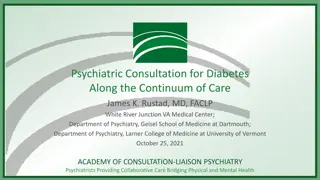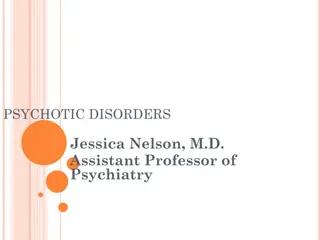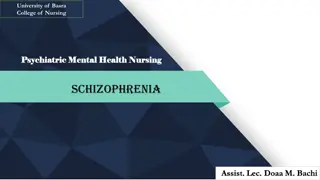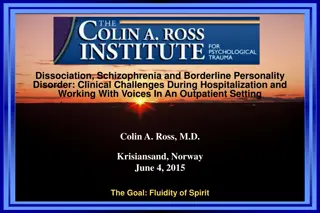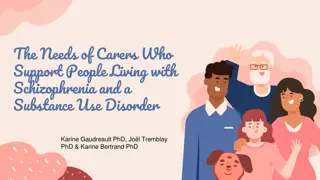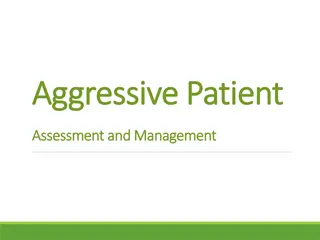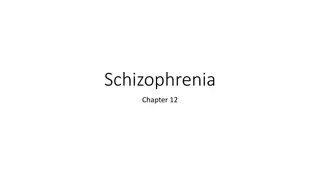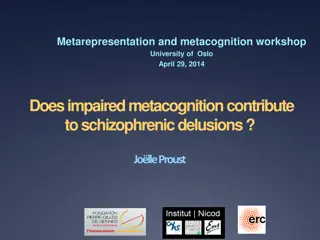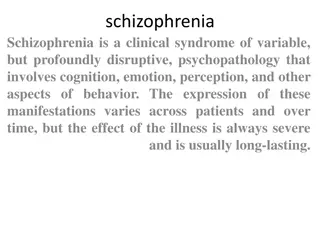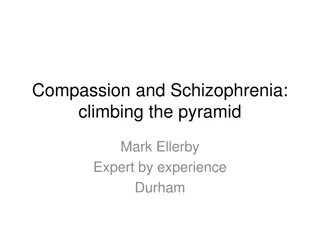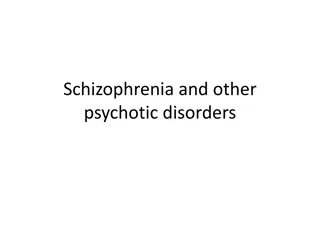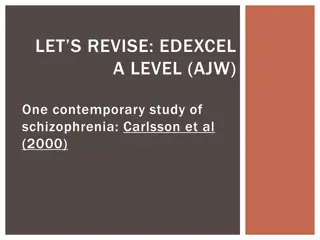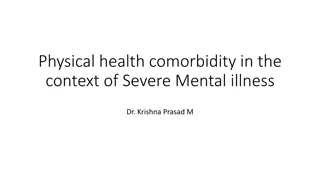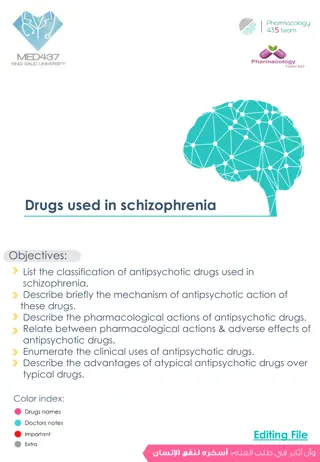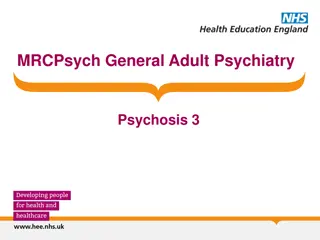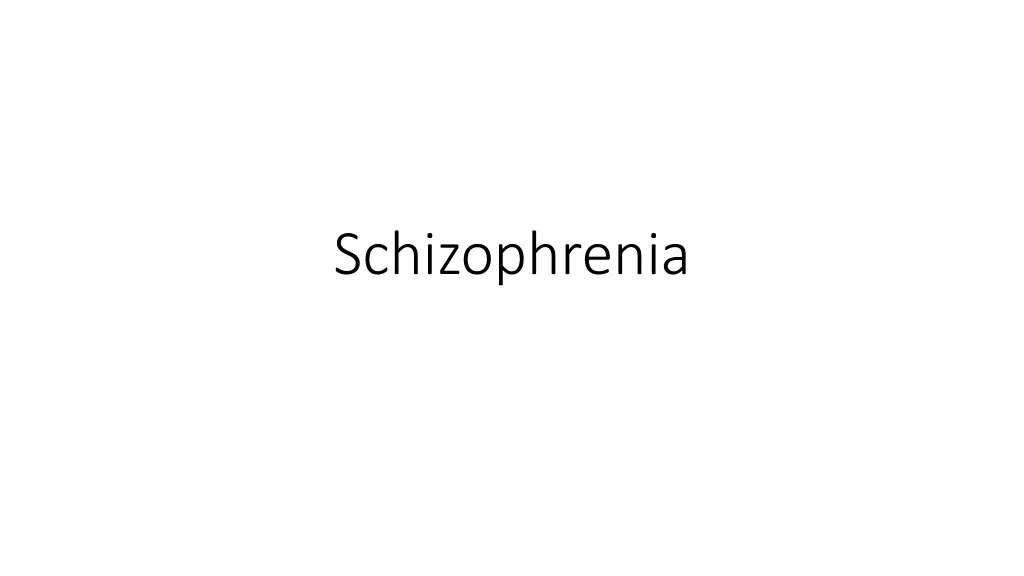
Understanding Schizophrenia: Explanations and Treatments
Explore the classification, symptoms, and various explanations for schizophrenia, including family dysfunction and cognitive factors. Learn about biological and psychological theories, drug therapies, and interventions like cognitive behavior therapy and token economies. Discover the importance of an interactionist approach in understanding and managing schizophrenia.
Download Presentation

Please find below an Image/Link to download the presentation.
The content on the website is provided AS IS for your information and personal use only. It may not be sold, licensed, or shared on other websites without obtaining consent from the author. If you encounter any issues during the download, it is possible that the publisher has removed the file from their server.
You are allowed to download the files provided on this website for personal or commercial use, subject to the condition that they are used lawfully. All files are the property of their respective owners.
The content on the website is provided AS IS for your information and personal use only. It may not be sold, licensed, or shared on other websites without obtaining consent from the author.
E N D
Presentation Transcript
Schizophrenia Classification of schizophrenia. Positive symptoms of schizophrenia, including hallucinations and delusions. Negative symptoms of schizophrenia, including speech poverty and avolition. Reliability and validity in diagnosis and classification of schizophrenia, including reference to co-morbidity, culture and gender bias and symptom overlap. Biological explanations for schizophrenia: genetics and neural correlates, including the dopamine hypothesis. Psychological explanations for schizophrenia: family dysfunction and cognitive explanations, including dysfunctional thought processing. Drug therapy: typical and atypical antipsychotics. Cognitive behaviour therapy and family therapy as used in the treatment of schizophrenia. Token economies as used in the management of schizophrenia. The importance of an interactionist approach in explaining and treating schizophrenia; the diathesis-stress model.
Psychological explanations for schizophrenia: family dysfunction and cognitive explanations, including dysfunctional thought processing.
Family Dysfunction This explanation proposes it is maladaptive relationships and patterns of communications within families that are the sources of stress that influence the development of schizophrenia. Three dysfunctional characteristics found in parents of schizophrenics include high levels of interpersonal conflict, difficulty communicating with one another and being excessively critical and controlling of the children. Gregory Batesons (1972) double blind theory describes family dysfunction occurring when children receive mixed and contradictory messages from their parents and this influences the onset of schizophrenia. A developing child may find themselves trapped in situations where they fear doing the wrong thing but mixed messages about what this is leaves them unable to talk about this. When they do make mistakes this leads to the withdrawal of love from the parents leaving them seeing the world as confusing and dangerous. This is then reflected in symptoms such as disorganised thinking and paranoid delusions.
1. Double bind theory: Gregory Bateson et al. 1956 suggests children who often receive contradictory messages are more likely to develop schizophrenia. These messages prevent the development of an internally coherent construction of reality which lead to schizophrenic symptoms. These ideas were echoed in the work of psychiatrist R.D. Laing who argued that schizophrenia is actually a reasonable response to an insane world. 2. Expressed emotion (EE): Negative emotional climate; elements include: verbal criticism of patients (violence), hostility towards the patient (anger or rejection), emotional over-involvement (needless self-sacrifice). Ex. Kuipers et al 1983 found that high EE relatives talk more and listen less. High levels of EE are more likely to influence relapse rates. Linszen et al 1997 found that a patient returning to a family with high levels of EE is 4 times more likely to relapse than returning to a family with a low level of EE
Family dysfunction Another variable related to family dysfunction is a negative emotional climate or high degree of expressed emotions. This is a communication style where family members of the sufferer talk about the patient in a critical or hostile manner as well be overly involved or concerned with them. Schizophrenics may have a lower tolerance for emotionally charged intensive family environments and this may lead to stress levels that are beyond their ability to cope triggering schizophrenia.
Dysfunctional Thought Processing Cognitive explanations of schizophrenia focus on dysfunctional thought processing and how schizophrenics process information differently. Frith et al (1992) identified two kinds of dysfunctional thought processing, metacognition (also known as meta-representation) and central control. The monitoring of one s own thought processes is known as metacognition and this includes a persons ability to detect errors in cognitive processing such as cognitive distortions. Metacognition also includes thinking about the feelings and behavioural reactions triggered by thoughts and feelings allowing them to view their own mental states and the intentions of others thus allowing them to make sense of their world. People suffering from schizophrenia are believed to experience a dysfunction in metacognition which results in them having dysfunctional thought processes which affect executive functioning and higher-level cognitive processes that manage cognitive and behavioural processes. This impairs goal-directed behaviour, attention, memory, cognitive flexibility, self-monitoring, inhibition of inappropriate responses and physical motor-control of oneself.
Dysfunctional Thought Processing Central control is the cognitive ability to suppress automatic responses while we perform deliberate actions instead. Schizophrenic symptoms such as disorganised speech and thought disorder are believed to be caused by this inability to suppress automatic thoughts and speech which are triggered by other thoughts. Schizophrenia sufferers tend to experience a derailment of thoughts and speech and this explanation proposes it is because each word during speech triggers associations the patient is unable to suppress.
Evidence Tienari (1994) measured the prevalence of schizophrenia in adopted children finding children with biological parents with the Schizophrenia were most likely to develop the disorder but this only emerged when the adopting family were rated as disturbed. This supports the case for how psychological factors such as family dysfunction (nurture) can trigger a genetic vulnerability (nature) in people leading to the development of schizophrenia.
Evaluation + A strength of the cognitive explanation is that it has practical applications. Yellowless et al. (2002) developed a machine that produced virtual hallucinations, such as hearing the television telling you to kill yourself or one person s face morphing into another s. The intention is to show schizophrenics that their hallucinations are not real. This suggests that understanding the effects of cognitive deficits allows psychologists to create new initiatives for schizophrenics and improve the quality of their lives. A final strength is that it takes on board the nurture approach to the development of schizophrenia. For example, it suggests that schizophrenic behaviour is the cause of environmental factors such as cognitive factors.
Evaluation - One weakness of the cognitive explanation is that there are problems with cause and effect. Cognitive approaches do not explain the causes of cognitive deficits where they come from in the first place. Is it the cognitive deficits which causes the schizophrenic behaviour or is the schizophrenia that causes the cognitive deficits? This suggests that there are problems with the chicken and egg problem. A second weakness of the cognitive model is that it is reductionist. The reason for this is because the approach does not consider other factors such as genes. It could be that the problems caused by low neurotransmitters creates the cognitive deficits. This suggests that the cognitive approach is over simplistic when consider the explanation of schizophrenia.
Question Jack has been diagnosed with schizophrenia. He describes his family background to his therapist: I could never talk to mum. She fussed over me all the time. I tried to do what she said, but could never please her. One minute she seemed all affectionate and the next minute she would make nasty comments. My dad hated all the arguments and stayed out of it. Describe the family dysfunction explanation for schizophrenia and explain how Jack s experiences can be linked to the family dysfunction explanation. (Total 8 marks)
Possible content: schizophrenia is due to family experiences of conflict, communication problems, criticism and control double-bind communication (Bateson 72) child receives mixed messages and cannot do the right thing results in disorganised thinking and paranoia high expressed emotion where family shows exaggerated involvement, control, criticism which increases likelihood of relapse (Kavanagh 1992); relapse rate is doubled (Butzlaff and Hooley 1998) psychodynamic theorists recognised a schizophrenogenic (schizophrenia-causing) mother typically cold, controlling and rejecting which leads to excessive stress which triggers psychotic thinking; father in such families is often passive. family schism and skew. Must apply to the STEM

